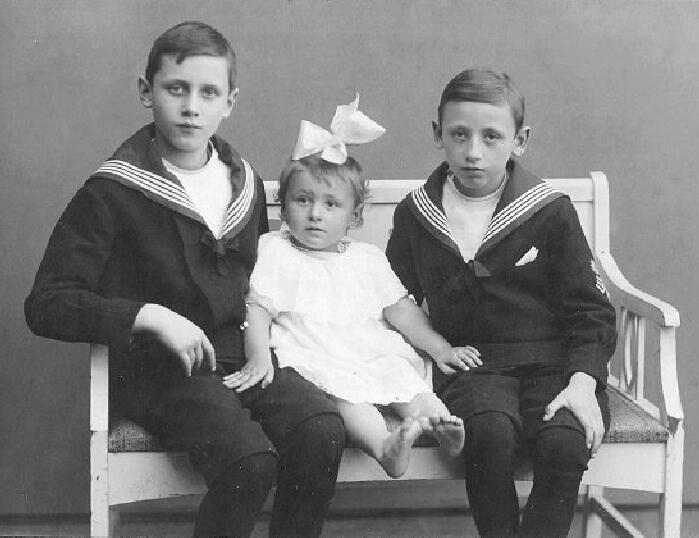
Figure 1.--These brothers with their little sister wear mathching sailors suits done un the traditional style modeled on the German naval uniform. The portrait is undated. |

|
We have noted sailor suits done in a wide range of different styles. There were an especially wide range of styles in the 19th century. This is the same pattern noted in other countries. There appears to have been in Germany and especially wide variety of non-traditional uniforms. Here a special factor concerning Germany could have been that the country did not begin building a substantial navy until the 1890s. The basic standard was the unifom of the Germany navy--heavily influenced by the British naval uniform. Some sailor suits from the beginning were styled traditionally lile the british or German naval uniforms. There were also some sailor suits which were styled fashionally with only the basic look of a sailor suit--namely the V-front and back flap. The traditional styles were done in black and white with the three stripes based on Nelson's three great victories.
The sailor suit wa a style introduced by the British royal family. The first sailor suit worn by the British princes was a scaled down replica of a Royal Navy uniform. We describe the sailor suit styling that is based on naval uniforms as traditional styling. Prince Wilhelm two decades later also wore a miniture Royal Navy uniforms (1860s). Many German boys wore traditional uniforms based on German naval uniforms. Of course German naval uniforms were very similar to British Royal Navy uniforms. We note as sailor outfits become increasingly popular, all kinds of stylistic variations appearing. Some were only modest variations on traditional styling. Others had on minimal traces of traditional styling. And there were all kinds of styles in between. At the turn-of-the 20th century we see traditional suits, but all kinds of non-traditional styles were popular. We see suits with multiple strip detailing rather than the traditional three stripes. We see the collars done in different ways and not just the classiv "V". Many were variations on the basic "V". After World War I these variations virtually disappearee and we mostrly see ther classic traditional styles.
The basic traditional standard for German children's sailor suits was the unifom of the Germany navy--heavily influenced of course by the British Royal Navy uniform. Some sailor suits from the beginning were styled traditionally lile the british or German naval uniforms. Boys thus wore both navy blue and white suits, seasonally like the Navy. The traditional styles were done in black/navy blue and white with the three stripes based on Nelson's three great victories. The most traditional suits had the "V" sailor collar and back flap with three stripe detailing, but we see many variations. Note that the sailor suits that the boys here are wearing have a very traditional look, but have detailing with four stripes rather than the three-stripes that were standard in Britain (figure 1).
We have noted sailor suits done in a wide range of different styles. There were an especially wide range of styles in the 19th century. This is the same pattern noted in other countries. There appears to have been in Germany and especially wide variety of non-traditional uniforms. I am not sure why these non-traditional styles were so popular in Germany. Here a special factor concerning Germany could have been that the country did not begin building a substantial navy until the 1890s. There were also some sailor suits which were styled fashionally with only the basic look of a sailor suit--namely the V-front and back flap. Others were closer to the look of traditional suits. Here we note a wide range of colors as well in contrast oo the navy blue and white of traditional suits.
Sailor suits were essentilly a rather plain, utilitarian style for children. Besides the military look, this was probably why it was apopular style with both boys and mothers. Mothers being mothers, hiwever, meant that some wanted fancier outfits. Manu mothers in the late-19th and early 20th century liked to dress their children, both boys and girls, in fancy styles. These ould have been outfits for special occassions. Some were so fancy that only the bare essentials of sailor styling were retained. These fancy styles varied, but often involved the addition of frills such as lace and ruffles. These fancy styles are of course non-traditional (non-uniform) styles, but it struck us that they were such a major deviation from uniform styles tjt they merited special consideration.
Navigate the Boys' Historical Clothing Web Site:
Sailor Suit Country Related Pages:
[Returnt to the Main country sailor suit pages]
[American]
[Denmark]
[English]
[French]
[German]
[Italian]
Other Related Pages:
[Sailor suits]
[Kilts]
[Smocks]
[Pinafores]
[Sailor Hats]
[Blouses]
[Ring Bearers]
[Long hair]
[Ringlet curls]
[Hair bows]
[Bangs]
[Collars]
[Bows]
Navigate the Boys' Historical Clothing Web Site:
[Return to clothing styles]
[Introduction]
[Activities]
[Biographies]
[Chronology]
[Clothing styles]
[Countries]
[Topics]
[Bibliographies]
[Contributions]
[FAQs]
[German glossary]
[Images]
[Links]
[Registration]
[Tools]
[Boys' Clothing Home]
Navigate the Historic Boys' Clothing Web German pages:
[Return to the Main German sailor suit page]
[German choirs]
[German country page]
[German school wear]
[Lederhosen]
[German youth groups]
[German royal family]
